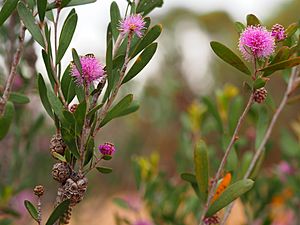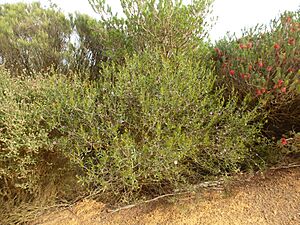Melaleuca glena facts for kids
Quick facts for kids Melaleuca glena |
|
|---|---|
 |
|
| M. glena leaves, flowers and fruit | |
| Scientific classification | |
| Genus: |
Melaleuca
|
| Species: |
glena
|
Melaleuca glena is a special plant that belongs to the myrtle family, called Myrtaceae. It is only found in the southern part of Western Australia. This plant looks a bit like another well-known plant called Melaleuca nesophila. Both have pretty purple "pom-pom" shaped flowers. However, Melaleuca glena is a smaller bush, and its flowers usually grow along the sides of its branches, not just at the very ends.
What it Looks Like
Melaleuca glena is a shrub that can grow up to about 2 m (7 ft) tall. It has bark that feels like paper. Its young stems are smooth.
Its leaves are flat and shaped a bit like a narrow egg. They are about 24–46 mm (0.9–2 in) long and 6.5–10.5 mm (0.3–0.4 in) wide. The ends of the leaves are rounded, and you can see 5 to 7 lines (veins) running along them.
Flowers and Fruits
The flowers of Melaleuca glena are a lovely shade of pink to purple. They grow in round clusters or spikes, usually along the sides of the branches. These flower spikes can be up to 15 mm (0.6 in) wide. Each spike is made up of 5 to 12 small groups of three flowers.
The outside parts of the flowers, especially when they are still buds, are covered with soft, white, silky hairs. The petals are tiny, only about 1.2–1.8 mm (0.05–0.07 in) long, and they fall off as the flower gets older. Each flower has five groups of stamens (the parts that make pollen), with 4 to 7 stamens in each group.
This plant blooms in spring and early summer. After the flowers, it grows woody fruits that look like small capsules. These capsules are about 2.5–3.5 mm (0.098–0.14 in) long and grow in round clusters along the stem. These fruits hold the seeds for new plants.
Where it Comes From
The plant Melaleuca glena was first officially described in 1999 by a scientist named Lyndley Craven. He wrote about it in a scientific journal called Australian Systematic Botany. The first plant he studied was found near a place called Scaddan.
The name glena comes from an Ancient Greek word, glenos. This word means "a thing to stare at" or "a thing to wonder at." This name was chosen because of how the flowers grow on the sides of the branches, making them easy to see and admire.
Where it Grows
You can find Melaleuca glena in the Wittenoom Hills and Fitzgerald River areas, which are near Esperance in Western Australia. It grows in areas with shrubland (bushes) and mallee (a type of eucalyptus forest). It likes to grow in clay soil that is on top of granite rock, laterite (a type of soil), or a special rock called spongolite.
Is it Protected?
The Government of Western Australia's Department of Parks and Wildlife says that Melaleuca glena is "not threatened." This means it is not currently in danger of disappearing.


